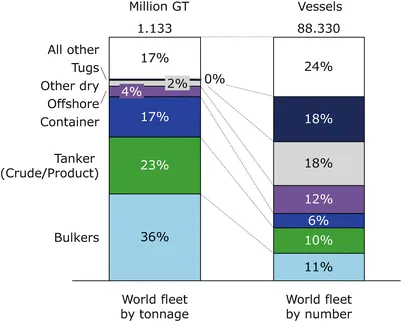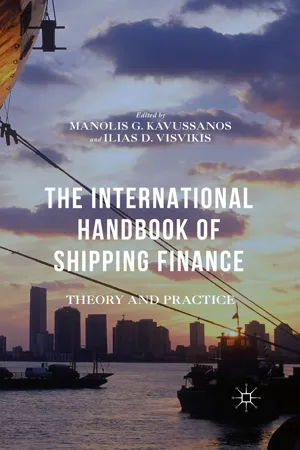1.1 An Introduction to Shipping
1.1.1 The Maritime Value Chain

1.1.1.1 Ship Owner
1.1.1.2 Shipyards
1.1.1.3 Charterers
1.1.1.4 Cargo Owners
1.1.1.5 Freight Forwarders
1.1.1.6 Ship Managers
1.1.1.7 Brokers
1.1.2 The Shipping Segments


The International Handbook of Shipping Finance is a one-stop resource, offering comprehensive reference to theory and practiceintheareaof shipping finance. In the multibillion dollar international shipping industry, it is importantto understand the various issues involved in the finance of the sector. This involves the identification and evaluation of the alternative sources of capital available for financing the ships, including the appraisal and budgeting ofshipping investment projects; legal and insurance aspects of ship finance; the financial analysis and modelling of investment projects; mergers and acquisitions; and the commercial and market risk management issues involved.
Edited by two leading academics in this area, and with contributions from 25 prominent market practitioners and academics over 16 chapters, this Handbook covers shipping finance and banking, maritime financial management andinvestments. As such, it includes: shipping markets; asset backed finance; shipbuilding finance; debt finance; public and private equity and debt markets; structured finance; legal aspects and key clauses of ship mortgages; marineinsurance; mechanisms for handling defaulted loans; investment appraisal and capital budgeting; financial analysis and investment modelling; business risk management and freight derivatives; and mergers and acquisitions. Thus, theHandbook offers a rigorous understanding of the different aspects of modern shipping finance and maritime financial management and investments, the various characteristics of the available products, the capital needs andrequirements, and a clear view on the different financial management strategies through a series of practical examples and applications. Technical where appropriate, but grounded in market reality, this is a "must-have" reference foranyone involved in shipping finance, from bank practitioners and commodity trading houses, toshipbrokers, lawyers and insurance houses as well as to university students studying shipping finance.
Table of Contents
Preface by Editors
Manolis Kavussanos, Professor, Director, MSc in International Shipping, Finance and Management, Athens University of Economics and Business, Greece
Ilias Visvikis, Professor, Director Executive Education and Professional Development, World Maritime University, Sweden
Chapter 1: Shipping Markets and their Economic Drivers
Jan-Henrik Huebner, Head of Shipping Advisory, DNV GL, Germany
Chapter 2: Asset Risk Assessment, Analysis and Forecasting in Asset Backed Finance
Henriette Brent Petersen, Head of Shipping & Offshore Research, DVB Bank SE, The Netherlands
Chapter 3: Overview of Ship Finance
Fotis Giannakoulis, Research Vice President, Morgan Stanley, USA
Chapter 4: Shipbuilding Finance
Charles Cushing, C.R. Cushing & Co. Inc., USA
Chapter 5: Debt Financing in Shipping
George Paleokrassas, Partner, Watson, Farley & Williams, Greece
Chapter 6: Public Debt Markets for Shipping
Basil Karatzas, Founder & CEO, Karatzas Marine Advisors & Co., USA
Chapter 7: Public and Private Equity Markets
Jeffrey Pribor, Global Head, Maritime Investment Banking, Jefferies LLC, USA
Cecilie Lind, Associate Investment Banking, Jefferies LLC, USA
Chapter 8: Structured Finance in Shipping
Contributor: Ioannis Alexopoulos, Director, Shipping Financier, Eurofin Group, Greece
Nikos Stratis, Managing Director of Augustea Group, UK
Chapter 9: Key Clauses of a Shipping Loan Agreement
Kyriakos Spoullos, Solicitor, Norton Rose Fulbright, Greece
Chapter 10: Legal Aspects of Ship Mortgages
Simon Norton, Lecturer, Cardiff Business School, UK
Claudio Chistè, Investec Bank Plc., UK
Chapter 11: Reasons and Mechanics of Handling Defaulted Shipping Loans and Methods of Recovery
Dimitris Anagnostopoulos, Board Member & Director, Aegean Baltic Bank, Greece
Philippos Tsamanis, VP - Head of Shipping, Aegean Baltic Bank, Greece
Chapter 12: Marine Insurance
Marc Huybrechts, Professor, University of Antwerp, Belgium
Theodora Nikaki, Associate Professor, Swansea University, UK
Chapter 13: Maritime Investment Appraisal and Budgeting
Wolfgang Drobetz, Professor, University of Hamburg, Germany
Stefan Albertijn, CEO, HAMANT Beratungs-und Investitions GmbH, Germany
Max Johns, Managing Director, German Shipowners' Association, Germany
Chapter 14: Financial Analysis and Modelling of Ship Investments
Lars Patterson, Shipping Investment Analyst, Pacomarine Limited, UK
Chapter 15: Maritime Business Risk Management
Manolis Kavussanos, Professor, Director, MSc in International Shipping, Finance and Management, Athens University of Economics and Business, Greece
Ilias Visvikis, Professor, Director Executive Education and Professional Development, World Maritime University, Sweden
Chapter 16: Mergers and Acquisitions in Shipping
George Alexandridis, Associate Professor, ICMA Centre, University of Reading, UK
Manish Singh, Manish Singh, Group Director - Strategy and M&A, V. Group Limited, UK

